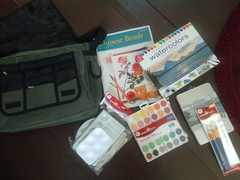
Hello everyone, it's Stephen Smith. Mari has so courteously invited me back to share more of my Journaling Practice with you. Today I want to talk about using a video camera to create a "Video Journal."
I spend a lot of my days seated at a desk in my home office banging out articles like this and building websites for small businesses. So, to get a little variety, I like to get outside once in a while. I have found that I can do a lot of really creative thinking out in the woods and up on the mountains. I take a notebook with me, a small video camera, a tiny tripod, and sometimes my watercolor painting gear (note, I am really not good at the painting, but I will be taking a class this summer).
Once I get out away from the crowds, the cars, the distractions of everyday life, I open up my "Notebook of Worthless Ideas" and start jotting down whatever comes to mind. If nothing comes to me right away I might just sit and enjoy the scenery or take a shot at drawing or painting.
The point is to get out of my normal environment so that the creativity really gets going. When that idea does come to me, or when I flip back through the pages of the NoWI in search of inspiration, I write down everything that I can. I try to explore possibilities for what I could do with that idea, what my colleagues might be able to do with it, is it something that I can make and sell? Sometimes the ideas come at a fast-and-furious pace, other times I actually head out to meditate on a pre-selected idea (that is where the idea for my book Work. Smarter. came from...) in order to get away from the distractions and really create an atmosphere for concentration and creativity.
I wrote a pretty long piece about this a while back:
Find or create a place to think
This is more important than people believe it is. When you are in a different place than when you normally do your work your mind is able to be open to new pathways and creativity because of the change in your environment. When you are sitting at your desk you will have a specific state of mind based on the normal, routine things that you regularly do there. In addition, you may feel guilty about not working on the urgent things that are in your to-do list, which can seriously inhibit creative thinking. Stephen Covey has a lot to say about this in The Seven Habits of Highly Effective People, especially about how the Urgent can overwhelm the Important. Setting aside time to think and be creative is important - both to your effectiveness and to your mental health. Just thinking or worrying about being interrupted during your thinking time can stymie your creativity, what would someone think if they walked in on you staring at a piece of blank paper? Or, worse yet, seeing you doodling sketching out some ideas in a mind-map? Finally, finding a special place to go and do some creative thinking will, over time, act like a reinforcement to generating and sustaining your own creative thinking mind-set. Your "Thinking Spot" should be conducive to reflection and introspection. Be mindful of your breathing. You may even discover a little routine of breathing in a particular way just before you "start to think". Small rituals like this are what Jonathan Fields calls "certainty anchors", small acts that become guideposts in your mind for specific behavior.
What about the Video Journal?
I'm getting to that. When the creative thinking session is over, when I feel like I have done what I could with the time I set aside, it's time to get out the camera. I set it up on the little tripod, point it at myself and hit record. Then I start talking about what I have been thinking and making notes about. I have found that actually speaking out loud can help to clarify some points of thought or even introduce new questions. I made this video after one such session, up near the top of Mt Major, near Alton, New Hampshire: (This video originally accompanied a blog post on how I do Creative Thinking, and was an introduction to the Notebook of Worthless Ideas)
As you can see this video was made with the intention of sharing with the general public. Yours doesn't have to be. It can be as personal as you want to make it, YouTube has a couple of privacy settings for you to choose from. It is easier to make a Video Journal than you might think, you don't have to get very elaborate. Many laptops have cameras built right in to the screen and you can record yourself wherever you are and send that video straight to your YouTube account. You will find that it gets to be much more comfortable talking to the camera after a few of these video recordings and you can play around with various video editing tools that exist to create fun effects. If you do decide to experiment with a video journal be sure to stop back here and post a link. We'd love to see it!
About the author: Stephen Smith writes about Productivity and Social Media Literacy at the In Context Blog. His e-book, a compilation of best practices for personal and business development, is called Work. Smarter. and will be available very soon. Like in a week. Learn more here: Work. Smarter. the book. You can follow him on Twitter at @hdbbstephen.

Leave Comment